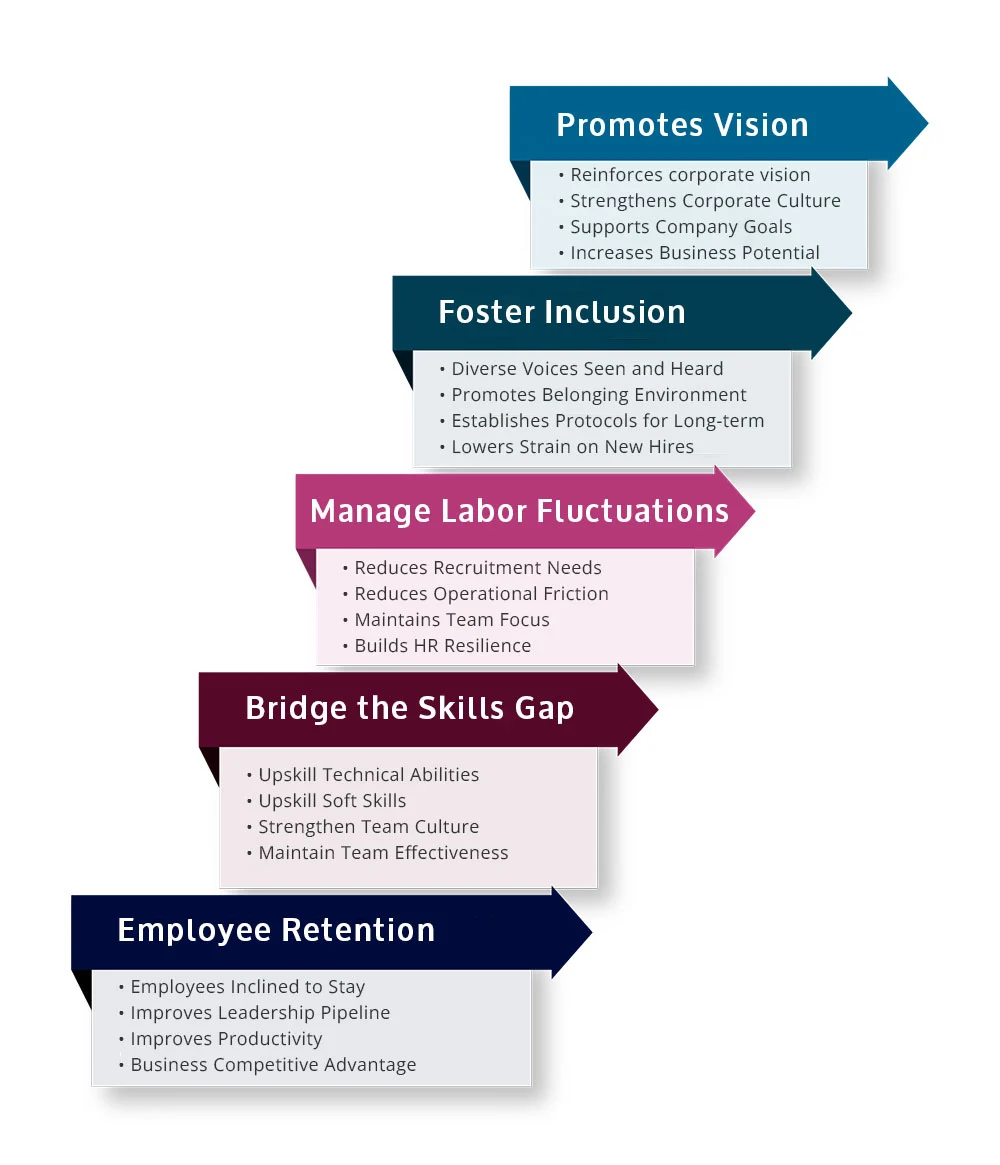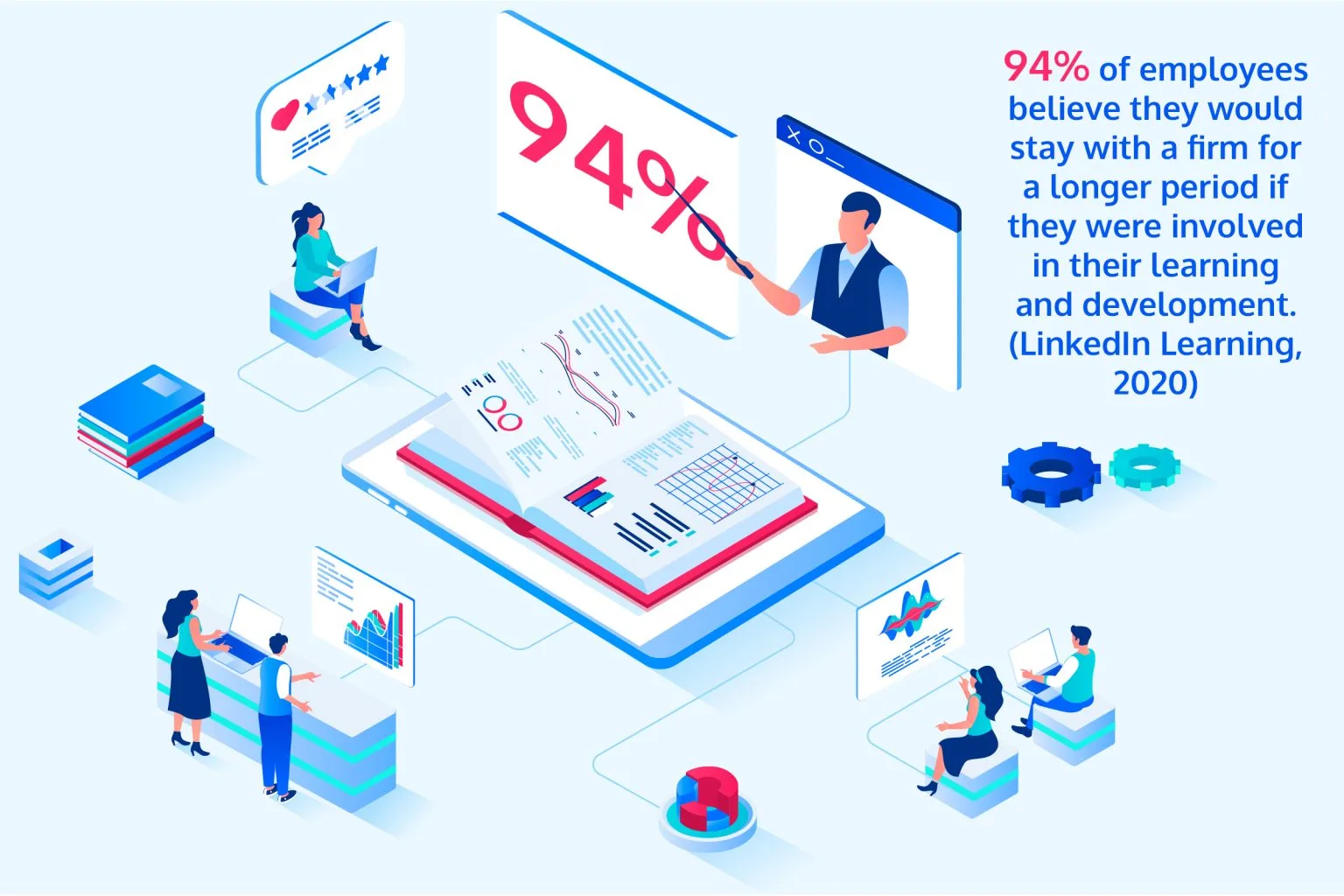Professional Development Courses for Employees
LinkedIn’s 2018 Workplace Learning Trends reported that 94% of employees would stay longer in companies that are willing to invest in professional development for staff members.
This statistic is from 2018, however, its message is still relevant: employees want to grow and they stay with companies that help them do it. Unfortunately, professional development programs are frequently viewed as perk by management. A nice-to-have versus a smart business investment.
Here’s another statistic: 70% of employees are inclined to quit their current job to work for a company that invests in employee development and learning. (Lorman, 2021).
Given the ongoing business skills labor shortage in the tech sector and the ever-widening skills gap, can you afford to potentially lose 70% of your workforce? Does the price of professional development training truly exceed the costs associated with replacing lost workers?
Then there’s the question of what type of professional development training delivers the best ROI. Technical? Non-technical? Both?
Traditionally, technical skills are given prominence—and with good reason. As fast as technology is advancing, technical professionals need to keep their tech acumen finely honed.
However, soft skills such as professional growth and leadership training are gaining more attention. Why? Because soft skills improve human interaction. And as society becomes more digitally dependent, our ability to interact with each other effectively is diminishing. The result is a workforce that doesn’t communicate well, navigate change efficiently, or resolve conflict skillfully.

Think about the time and energy it costs to overcome employee development program hurdles. Ignoring them prevents teams and organizations from producing next level results. Teams needing professional skills training will have lower productivity and ultimately will produce lower revenue. Couple this with the cost of potentially losing a large chunk of your workforce because you aren’t helping them advance their skills or improve their career paths and professional development courses for employees take on greater importance.
We want to help you boost your knowledge about professional development. The professional development sector has come a long way from all-day, conference room-based events. Use the following information to gain a holistic view of today’s professional development landscape and how it’s supporting business missions across industries.
Business benefits of professional development training
Soft skills may seem woo-woo, but their impact on your long-term business goals shouldn’t be underestimated. The more your team functions as a cohesive whole, the faster problem solving becomes and the more momentum you gather. Consider the following benefits:
Employee retention. As our opening statistics demonstrated, employees stick with organizations that keep them engaged and help them grow. Including soft skills training in your team training offerings not only boosts employee retention, but it also facilitates a leadership pipeline, improves productivity, and gives your business a competitive advantage in the marketplace.

Bridge the skill gaps. Typically, we think of the skill gap in terms of upskilling technical abilities. However, there’s a significant soft skill gap in today’s work environment as well. From old standards, like communication skills, to new issues, like managing hybrid teams, our business environment demands a very different soft skill set than the past’s low-tech landscape. Bridging this gap strengthens your cultural fabric and keeps your team effective in today’s interpersonal situations.
Weather labor fluctuations. Fostering a strong, well-rounded work force that supports career goals removes the need to recruit talent. Whether there’s a labor shortage or a labor glut, your HR team doesn’t have to put time and effort into sourcing suitable resources or looking for that one person with a specific skill. Their efforts can stay focused on supporting your current team.
Foster acceptance and inclusion. Diversity and inclusion are hot topics in today’s business environment. Many organizations struggle to create an environment where more diverse voices can be seen and heard effectively. Diversity, Inclusion & Belonging (DI&B) training helps establish long-term workplace protocols and etiquette that promote belonging and foster a culture of inclusivity all new hires can step into easier.
Promotes a cohesive corporate vision. Beyond facilitating productive interpersonal communications, arming your team with strong soft skills is a powerful way to strengthen your corporate culture and is one of the best ways to get team buy-in for company goals. A united workforce is a powerful asset that can lift your business to untold heights.
The big picture takeaway is soft skills help you create a more competent and productive organization. This creates a rock-solid foundation for your company’s future; you can focus on growth and advancement instead of managing an out-of-sync workforce.
Today’s soft skill landscape

- Emotional intelligence
- Critical thinking
- Diversity, Inclusion & Belonging (DI&B)
- Data set construction
- Hybrid team management
- Stress and anxiety management
- LGBTQ+ awareness
These are skills that aren’t intuitive and yet, helping your workers develop these new skills, creates a people-centric environment of high-potential employees.
As a business leader, it’s critical to recognize that barebones professional development training isn’t enough in today’s marketplace. The business environment has advanced far beyond a time management class here and a public speaking class there. Your team members are facing more complex issues and situations than ever before. Helping them develop skills that address these complexities keeps your business on track and moving forward.
Today’s professional development delivery modalities
Today, employee training comes in a wide array of delivery modalities that give businesses the flexibility to undertake this process in the most effective way for them. Here’s a rundown on training program delivery methods in today’s marketplace:

Self-directed learning. This is a no/low-cost method of professional development. However, its success and effectiveness hinges on the participant(s) being highly motivated and disciplined. Self-directed learning options can range from the analogue (e.g., books, user groups, workshops,) to digital (e.g., on-line courses, podcasts, webinars). This is a useful option for teams in remote locations or in varying time zones.
Classroom training. This traditional delivery modality still has a place in today’s professional development environment. Afterall, soft skills center around interpersonal interactions. Learning them in person in a group setting from an instructor with professional experience has merit. These instructor-led programs deliver structured learning environments that provide support and guidance needed for certain sensitive topics, like those dealing with race and gender.
E-learning. The COVID pandemic revolutionized the e-learning landscape. The result is a robust learning environment that makes career growth via the internet a viable option. The online learning environment offers individual learning opportunities as well as group sessions. A virtual environment accommodates disparate locations, time zones, learning styles, missions, and goals. And the technology for it has made rapid advancements elevating its sophistication and interaction levels.
Choosing a professional development training provider
The market is glutted with training providers. How do you find one with relevant, high-quality training? Throw a dart?
We see companies grappling with this question on a regular basis. Here are five points to consider when vetting a professional development training provider.
Check their skill set. This may seem like a waste of time, right? However, it’s worth asking if the provider has a specialty or caters to a specific niche. For example, CCS Learning Academy is a professional training provider, but our foundation is in technology, and we specialize in helping tech teams. This allows us to create training experiences that resonate with this demographic. Uncovering these hidden skills allows you to choose a training provider more in line with your workers’ needs and your company’s goals.
Clarify what’s included. Believe it or not, not every training provider includes course materials (e.g., study guides, quizzes, manuals, etc.) in their fees, especially when it comes to professional development training as these topics typically don’t use standardized course content. One best practice is to clarify what your fee includes. If there are add-ons it is better to know about them before you sign a contract.
How are instructors sourced. Every training provider will say their instructors are certified. Certified in what? Are these people following a script or are they truly SMEs in their field with sufficient experience needed to answer the most nuanced questions? Don’t be afraid to ask for instructor bios or for their LinkedIn information. Learning more about the instructor also ensures you have someone who your team connects with and will find engaging.
Customer support parameters. Customer support can apply to a wider range of activities: IT issues, billing concerns, scheduling, etc. When evaluating training providers, it’s important to find out what type of support your team receives in terms of mastering the new skills and completing the training. When can they access the instructor? Can they receive mentoring? Is there an administrative support team available? This type of customer support is particularly critical for online learning where individuals are working on their own.
Validate curriculum age. Professional training information changes as quickly as everything else in the marketplace. Beyond ensuring the training provider offers relevant topics, you also want to look at how often the curriculum is updated. A course built in 2020 won’t include information germane to today’s business climate and may leave your team lacking key skills. You want to clarify that the course information is as current as possible.Get In Touch
© 2025 CCS Learning Academy. All Rights Reserved





